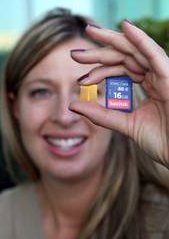
Posted on Tuesday, October 13 2009 @ 18:58 CEST by Thomas De Maesschalck
SanDisk announced it started shipping the first NAND flash memory chips that pack four bits of data per cell, twice as much as conventional MLC NAND memory chips. The X4 technology enables SanDisk to create 43nm NAND flash memory chips with a capacity of 64Gb, the highest-density single-die memory device in the world to enter production. The company is shipping 8GB and 16GB SDHC and Memory Stick PRO Duo memory cards using X4 technology.
Based on 43-nanometer (nm) process technology, the 64-gigabit (Gb) NAND flash chip is the highest-density single-die memory device in the world to enter production. SanDisk is shipping 8 gigabyte (GB)1 and 16GB SDHC cards as well as 8GB and 16GB Memory Stick PRO Duo™ cards using X4 technology.
"The development and commercialization of X4 technology represents an important milestone for the flash storage industry," said Sanjay Mehrotra, president and chief operating officer, SanDisk. "Our challenge with X4 technology was to not only deliver the lower costs inherent to 4-bits-per-cell, but to do so while meeting the reliability and performance requirements of industry standard cards that employ MLC NAND. Our world-class design and engineering team has applied its deep experience with high speed 2 and 3-bits-per-cell flash chip designs and collaborated closely with our leading design partners to develop and perfect new and powerful error correction algorithms to assure reliable operation. This intensive multi-year effort has generated powerful new patents and know-how, and demonstrates SanDisk's relentless drive for innovations that result in the ever expanding use of flash storage in consumer applications such as music, videos, photos, games and numerous third party applications."
"The shipment of 4-bits-per-cell technology is a necessary evolution for the industry," said Joseph Unsworth, research director, Gartner. "Enabling this technology in mainstream products demonstrates a cost advantage in the flash memory industry that considers 2-bits-per-cell in a memory device as standard. The NAND industry continues to see a rapid pace of innovation, and adoption of this technology will be essential to remain competitive."
